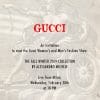“Beauty not perceived is a pleasure not felt,” wrote the Spanish-American poet and philosopher George Santayana, chosen by Karl Lagerfeld to introduce The Glory of Water, his latest photography book and exhibition supported by Fendi. “You know Santayana? I’m very happy that a young person, and from Asia, knows who he is. Not many people in Europe even do,” says Lagerfeld in surprise, after I cite the fascinating prologue to his 120-page cloth-bound book published by Steidl, which turns his lens on the iconic fountains of Rome. “Santayana’s The Sense of Beauty is one of my favourite books … ”
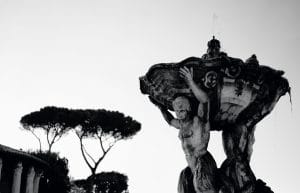
Fotana dei Tritoni
We are seated, just him and I, on deck chairs along the embankment of the Seine by the gilded Pont Alexandre III, the Eiffel Tower on the other side of the river beyond us, a fresh summer’s breeze enhancing the moment. Behind us, the exhibition space of five black vinyl geometrical domes, which mirror the major cupolas of Rome, casts a surreal presence against postcard Paris. Inside the exhibition, Lagerfeld’s deeply engaging photographs of Rome’s fountains in traditional daguerreotypes and platinotypes await their launch that very evening. The music of Vivaldi, the chiming sounds of fountain water, and smoke machines add to the supernatural ambience.
“You do what you feel, you do your work, and only later when you think it over, you think where comes the idea point, and how you approached the idea,” states Lagerfeld. “I didn’t start with a quote from Nietzsche or Santayana but only in retrospect did I feel it captured the very idea of this project.”
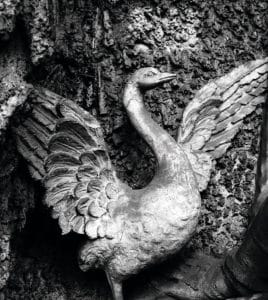
A close-up of Fontana dei Tritoni
The designer’s photographic project marks a USD2.8 million restoration effort undertaken by Fendi to preserve Rome’s unique heritage, particularly the Trevi Fountain, the ‘Quattro Fontane’, and other iconic Roman fountains.
Rome, the birthplace for Fendi in 1925, has always been the city of its inspiration, and ‘Fendi for Fountains’ conceived by Pietro Beccari, chairman and chief executive of Fendi, is vital to “promote a positive message of reconstruction, renewal, and restoration far beyond its borders, as a strong sign of change.”
“It’s a way of giving back to the city that has given Fendi so much,” says Beccari, who immediately called the Mayor of Rome upon hearing on the radio, while driving through the city, that parts of the elaborate cornice of the 300-year-old Trevi Fountain were crumbling. Thorough restoration work is scheduled to take 20 months. “These fountains are amazing works of engineering, the aqueducts working with the elaborate baroque design; to think that they were constructed in the 18th Century,” says the charismatic Italian earlier in the day at Fendi’s new maison at Avenue Montaigne in Paris, launching that same evening. “We are privileged to be involved in a project that will make a difference, and that also reinforces Fendi’s links with Rome.”
Lagerfeld echoes the sentiment. “Fountains represent the most important element of life, a human experience. In the past, it was the only way people got water, and for Rome they also have such historical importance – no other city is so defined by its water,” says the artistic director of Fendi, who has been to Rome more than 740 times in his life and 48-year career with the luxury brand. He took a week to capture the sculptures and statues, decorative elements, and aquatic energy of these iconic fountains – the Trevi most famously filmed in Federico Fellini’s La Dolce Vita (1960).
The medium is also the message. Fifty daguerrotypes – a direct positive made in the camera on a silvered copper plate – give an ethereal quality to Corinthian orders and bas reliefs, changing from positive to negative depending on the angle viewed. These prints are extremely fragile and can be smudged with a finger. The other fifty are platinotypes, a luxurious photo-chemical technique of printing with platinum and palladium on Japanese silk paper, which gives a warmer, deeper dimension to the images. It is said that a platinotype can last a thousand years. They could match the fountains in longevity is what seems to be Lagerfeld’s and Fendi’s hope.
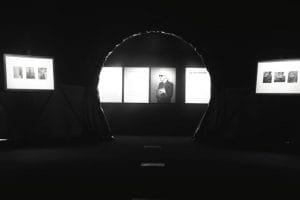
The juxtaposition of darkness and light further enhanced the beauty of the photography
Old fountains photographed with a traditional technique: I ask Lagerfeld if he was trying to evoke nostalgia, an emotion he often denounces, being a self-confessed futurist. “No, no, no,” he corrects. “I’m impressed with the things of the past that I do not know, I’m not impressed with everything I knew. I think that’s much more creative. That’s why I was impressed with the process of old photography. It’s fascinating, especially knowing how the images were taken, how photographers worked in a dark room, how people killed themselves with the products they had to inhale.
“I love the history of photography especially the parts I did not know – the glass plates, the first platinum prints, the monochromes, autochromes, the colour chromes – they are so strange,” he reels passionately. “Now you can fake things with computers, with colour effects, and take photographs just with a press of a button. That’s not photography.”
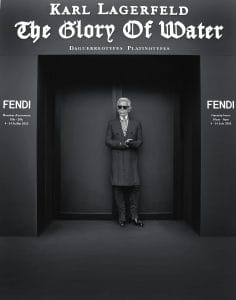
Karl Lagerfeld at the exhibition
The 10-day exhibition that will soon travel to New York and China also highlights the restoration of the 18-minute short film Histoire d’Eau shot in Rome in 1977 – with an opening scene at the Trevi Fountain – by Jacques de Bascher, starring Suzie Dyson dressed in the first ready-to-wear collection by Karl Lagerfeld for Fendi. The world’s first fashion film also features Silvia Fendi, a teenager then, with her mother and aunts – the famous five sisters of Fendi – in the private fur salon of the Roman luxury house.
History to fantasy and fashion. This latest multi-dimensional experience of Fendi comes almost sensually to Lagerfeld although he says it can be “quite academic.”
His signature drink arrives: Diet Coke. Two shots later by a 21st Century camera – the iPhone – and the maestro heads in to inspect the exhibition space that expresses his perception of beauty. “I like the idea that you know Santayana, really!”


